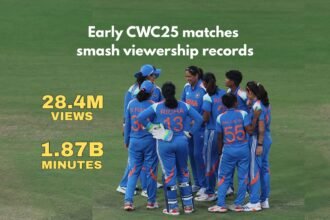New Delhi: Few ad placements are as coveted or as scrutinised as the front of India’s cricket jersey. From Wills and Sahara to Star, Oppo, Byju’s and Dream11, the logo on the chest promised mass affection and unmatched reach. Yet, a familiar storyline keeps returning: sponsors exit early or hit turbulence. With Apollo Tyres now unveiled as Team India’s new lead sponsor until March 2028, it’s worth asking: is there really a “jersey curse”, or are brands tripping over predictable business risks?
The pattern behind the “curse”
Look closely and the common thread isn’t mystique — it’s regulation, cost discipline and core-business fragility:
- Tobacco-era exit (Wills/ITC): India tightened tobacco advertising rules under COTPA (2003), which bans direct and indirect promotion and sponsorship. That policy arc led ITC’s Wills-branded presence to be phased out a regulatory end, not commercial collapse.
- Sahara (2001–2013): The longest-serving sponsor bowed out amid mounting regulatory and legal heat, culminating in founder Subrata Roy’s arrest again, troubles rooted in the group’s finances and compliance, not in the shirt itself.
- Star India (2014–2017): A strong stint ended by choice: Star didn’t renew as costs climbed and strategic priorities shifted; its CEO had flagged uncertainty around the cricket economy even before the handover to Oppo. This was classic cost–benefit recalibration.
- Oppo → Byju’s (2017–2019 → 2019–2023): Oppo’s record ₹1,079-crore bid proved unsustainable; it transferred the rights to Byju’s. The edtech unicorn later unraveled under losses, governance questions and funding stress marketing couldn’t mask a weakening core.
- Dream11 (2023–2025): The sponsor’s exit was triggered by Parliament’s Promotion and Regulation of Online Gaming Bill, 2025, banning real-money games and their promotion/sponsorship; BCCI said the deal had to be cut short to comply. That’s policy risk in its purest form.
In short: the jersey delivers reach; what breaks is usually elsewhere — in the regulator’s rulebook, in a CFO’s spreadsheet, or in a business model under strain.
Apollo Tyres’ deal — what’s known, and what’s different
The BCCI confirmed Apollo Tyres as India’s new lead sponsor in mid-September, replacing Dream11. The pact runs to March 2028 across men’s and women’s teams. While the board didn’t publish the fee, multiple reports peg the deal around ₹579 crore (≈ ₹4.5 crore per game), a bump on recent rates and a signal that shirt inventory remains premium. Competing bids reportedly came from Canva and JK Cement.
Why Apollo is not Byju’s (or Dream11):
- Category risk: Tyres are a regulated but stable industrial category not subject to the kind of sudden blanket prohibitions that hit tobacco or real-money gaming. (That said, auto cycles, raw-material swings and EV shifts are real business variables.)
- Balance of B2C & B2B: For a manufacturer, shirt visibility can power retail recall and channel incentives (dealer programmes, promotions, co-branded activations) in a way that’s more tangible than for a pure-play app.
- Runway of fixtures: The term covers two-and-a-half years of bilateral and ICC cricket, giving Apollo sufficient time to activate, not just advertise.
Is high visibility a blessing or a trap?
High-profile sponsorship magnifies everything: if governance is sloppy or unit economics are stretched, the scrutiny of being on India’s shirt accelerates the fallout. That’s why Star stepped back on cost logic, Oppo recalibrated an over-bid, Byju’s couldn’t out-market balance-sheet stress, and Dream11 was undone by a law, not by lack of eyeballs. The “curse” is really a stress test.
What brands must get right before bidding on the jersey
- Policy mapping & clauses: Avoid categories at risk of sudden bans; hard-wire compliance and exit/substitution clauses for regulatory shocks. (See Dream11’s fate under the 2025 law.)
- Price with a model, not FOMO: Treat the shirt as a full-funnel asset link media value to sales/retail lift and lifetime value, or walk away like Star did.
- Balance sheet first: If cash burn or debt covenants are tight, a nine-figure sponsorship can become the first cut in a downturn (Byju’s was the cautionary tale).
- Activate relentlessly: The logo is the entry ticket. Returns arrive via content, community, retail, and smart CRM not TV exposure alone.
Bottom line
Wills left because the law changed. Sahara crumbled under scrutiny. Star chose strategy over sentiment. Oppo overpaid. Byju’s overextended. Dream11 ran into a new statute. The shirt didn’t doom them; their context did. Apollo Tyres inherits the halo — and the microscope. If it prices prudently, activates deeply and steers clear of policy landmines, the “curse” should read like what it is: a myth that confuses visibility with viability.















